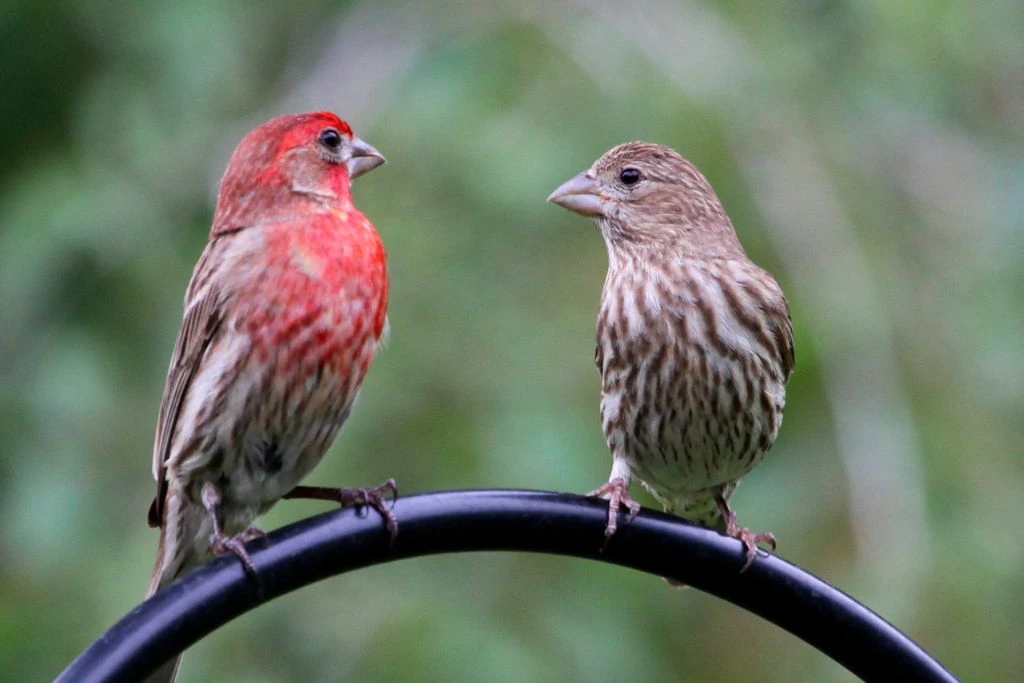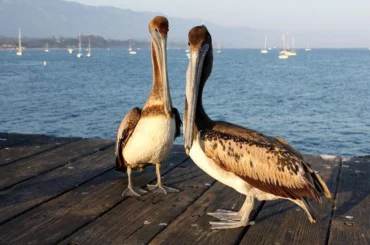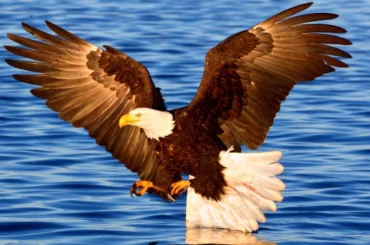California’s vast area is densely forested, with ample sun and a Pacific climate to support nature’s apiaries. Unsurprisingly, the finch is one of its occupants, as this small bird enjoys the eco-friendly backyards and bird feeders that Californians keep outside.
Finches are small to medium-sized songbirds with cone-shaped bills that are useful for cracking open seeds and nuts. Their bodies are round and compact, with notched tails and remarkably pointed wings.
Despite their small size, they are often easy to identify due to their vibrant yellow and red color combinations, which are predominant in males. The following are some finches that call California home.
1. House Finch

- Kingdom: Animalia
- Phylum: Chordata
- Class: Aves
- Order: Passeriformes
- Genus: Haemorhous Swainson
- Species: Haemorhous mexicanus
- Length: 5.1-5.5 in (13-14 cm)
- Weight: 0.6-0.9 oz (16-27 g)
- Wingspan: 7.9-9.8 in (20-25 cm)
All year long, House Finches live in California. They do not move and are listed on 47% of summer and 41% of winter bird watchers’ checklists submitted to the state. Male House Finch bodies are mostly dark with brown streaks, with a red head as well as breasts.
House Finches, formerly only found in the Western Unted States, were introduced to the Eastern United States and have thrived well, even displacing the Purple Finch. House Finches can be found in loud flocks that are difficult to miss in parks, farms, woodland edges, and backyard feeders. They consume fruit, seeds, and buds for food.
2. Lesser Goldfinch

- Kingdom: Animalia
- Phylum: Chordata
- Class: Aves
- Order: Passeriformes
- Genus: Spinus Koch
- Species: Spinus psaltria
- Length: 3.5-4.3 in (9-11 cm)
- Weight: 0.3-0.4 oz (8-11.5 g)
- Wingspan: 5.9-7.9 in (15-20 cm)
Lesser Goldfinches remain year-round in California. They are listed in 22% of the state’s winter and 30% of its summer checklists. Little brilliant yellow and black songbirds known as lesser goldfinches have long, pointed wings and short, notched tails. All year long, they are found in the Southwestern US and on the West Coast.
You can see Lesser Goldfinches in big flocks, in open settings, like thickets, weedy fields, woodland clearings, parks, and gardens. They hunt for seeds, particularly sunflower seeds, as well as elderberry, coffeeberry, cottonwood, willow, sycamores, and alder fruits and buds.
3. American Goldfinch
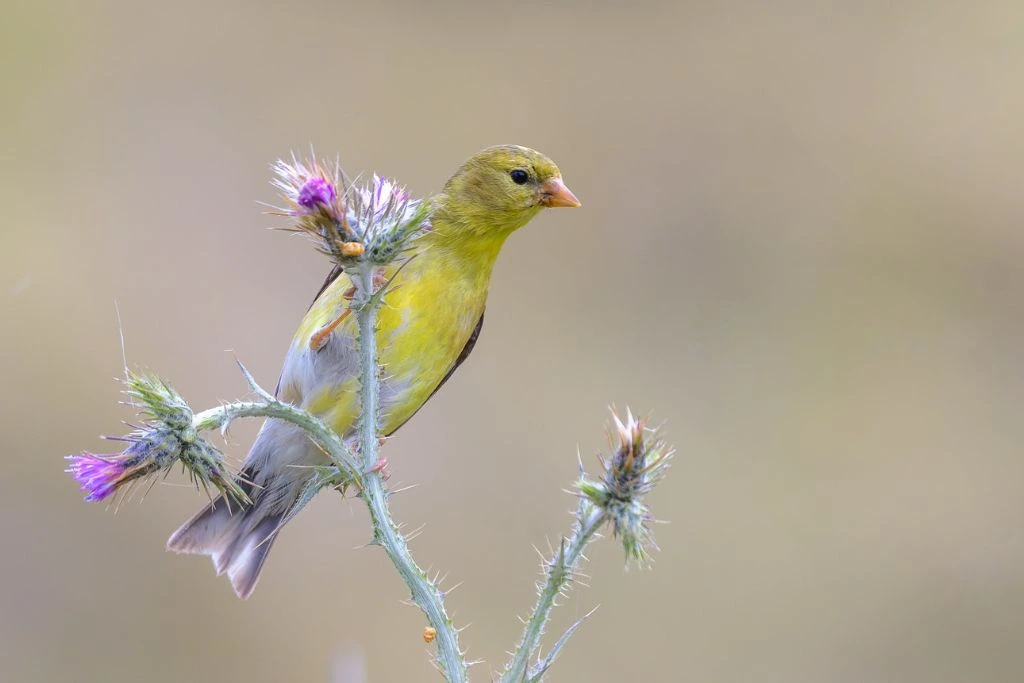
- Kingdom: Animalia
- Phylum: Chordata
- Class: Aves
- Order: Passeriformes
- Genus: Spinus Koch
- Species: Spinus tristis
- Length: 4.3-5.1 in (11-13 cm)
- Weight: 0.4-0.7 oz (11-20 g)
- Wingspan: 7.5-8.7 in (19-22 cm)
Throughout the year, Californians can see American Goldfinches, but between April and November, when they migrate, they become more numerous. They can be found in up to 11% of checklists throughout migrations and about 9% in summer. Popular birds include American Goldfinches. In the spring, the males show striking yellow and black colors.
Most of North America is home to the American Goldfinch, which stays there all year. American Goldfinches forage for sunflowers, thistle, and aster plants in weedy fields and unkempt places. They are also typical of backyards, parks, and suburbs.
4. Purple Finch
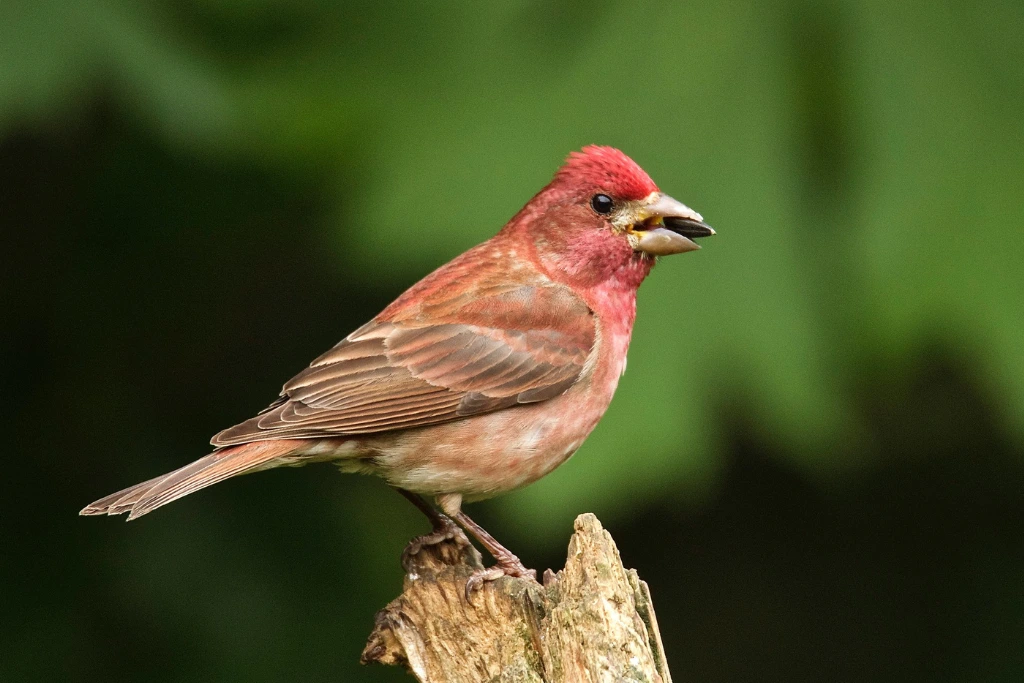
- Kingdom: Animalia
- Phylum: Chordata
- Class: Aves
- Order: Passeriformes
- Genus: Haemorhous Swainson
- Species: Haemorhous purpureus
- Length: 4.7-6.3 in (12-16 cm)
- Weight: 0.6-1.1 oz (18-32 g)
- Wingspan: 8.7-10.2 in (22-26 cm)
Despite being more frequent from March to mid-July, Purple Finches can be seen in California throughout the year. For the state, they are listed in 7% of the summer checklists and 3% of the winter checklists. Male Purple Finches have a paler belly, more brown on the back and wings, and reddish-purple heads and breasts.
Although they nest in Canada and spend the winter in Eastern states, Purple Finches are year-round Pacific and Northeast residents. In addition to seeds, Purple Finch also consumes buds, nectar, and cherries in evergreen forests. Purple Finches build their nests in tall trees consisting of weeds, bark, twigs, and moss.
5. Pine Siskin
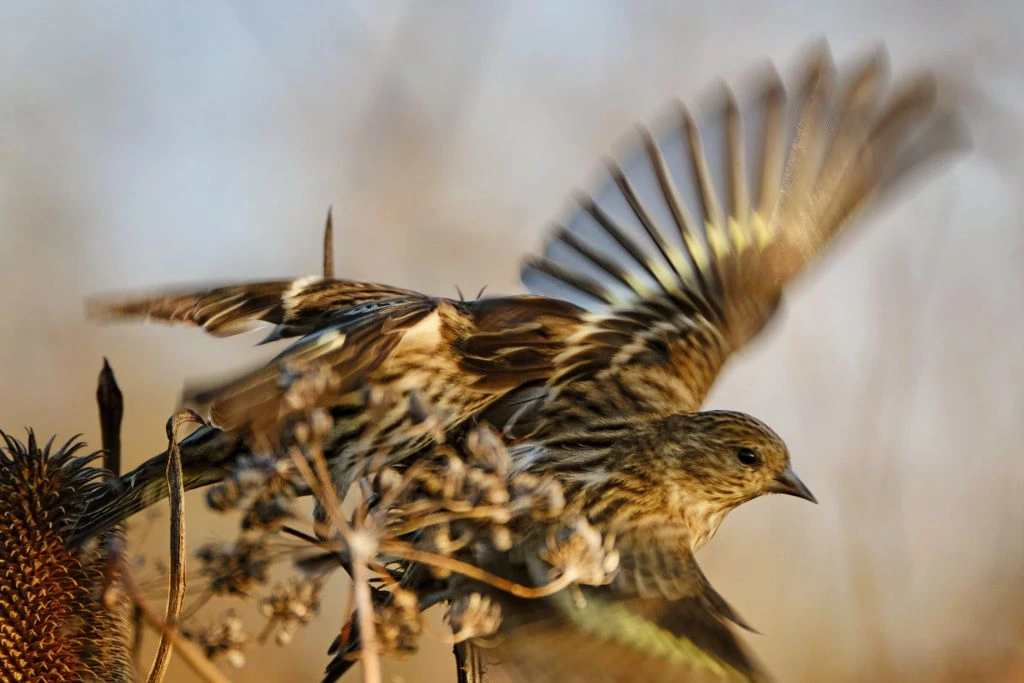
- Kingdom: Animalia
- Phylum: Chordata
- Class: Aves
- Order: Passeriformes
- Genus: Spinus Koch
- Species: Spinus Pinus
- Length: 4.3-5.5 in (11-14 cm)
- Weight: 0.4-0.6 oz (12-18 g)
- Wingspan: 7.1-8.7 in (18-22 cm)
Pine Siskins can be seen throughout the year in California, but they are more prevalent in the winter. They show up in 5% of checklists during winter and migrations and 2% in summer. Small brown finches called Pine Siskins have yellow tails and wing streaks. They have a short, pointed bill, pointed wings, and a forked tail.
Pine Siskins remain throughout the Western states’ pine forests and near the Canadian border. Some go south for the winter before reproducing in Canada. They can be found across many parts of North America, relying on pinecone yields. Pine Siskins, as their names implies, eat a variety of seeds, including those from grasses, weeds, and new buds in addition to pine seeds.
6. Lawrence’s Goldfinch
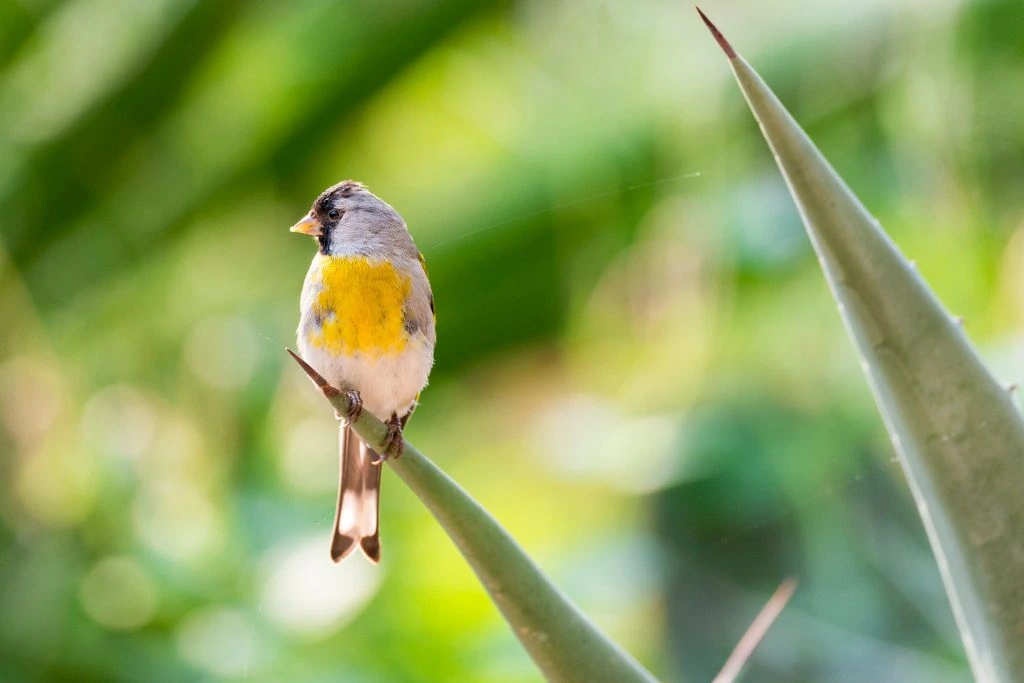
- Kingdom: Animalia
- Phylum: Chordata
- Class: Aves
- Order: Passeriformes
- Genus: Spinus Koch
- Species: Spinus lawrencei
- Length: 3.9-4.7 in (10-12 cm)
- Weight: 0.3-0.5 oz (9-14 g)
- Wingspan: 8.3 in (21 cm)
The best time to see Lawrence’s Goldfinches in California is from March through July. Some breed in the state’s north, while others migrate south during the winter. Small, roving songbirds, the males are immediately identifiable with just a black vertical stripe running across the front of their heads through their chins.
Breeding in California, Lawrence’s Goldfinches go only a few miles east and south. Open oak forests and shrubby regions are good places to look for Lawrence’s Goldfinch, especially if there is a body of water nearby. They can be found in weedy fields, brushy places, and streams throughout the winter.
7. Cassin’s Finch
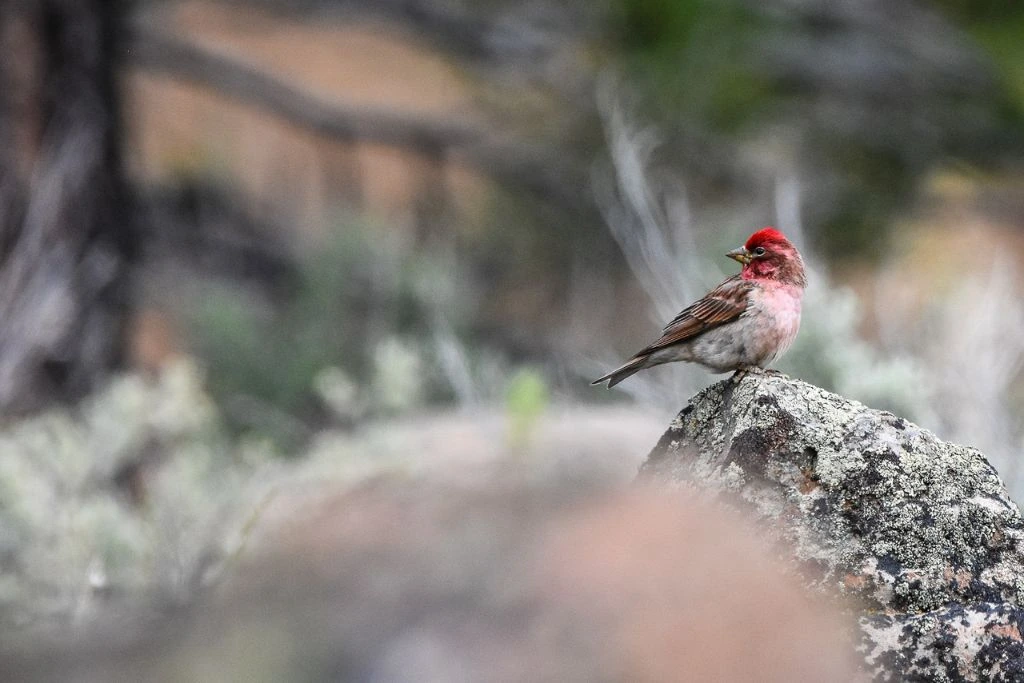
- Kingdom: Animalia
- Phylum: Chordata
- Class: Aves
- Order: Passeriformes
- Genus: Haemorhous Swaison
- Species: Haemorhous cassinii
- Length: 6.3 in (16 cm)
- Weight: 0.8-1.2 oz (24-34 g)
- Wingspan: 9.8-10.6 in (25-27 cm)
While some can be observed yearly, Californians are more likely to see Cassin’s Finches from May through August. Male Cassin’s Finch characteristics include a red crown, soft pink head, red breasts, a whitish belly, a brown back, and brown wings. All year long, Cassin’s Finches can be found in the mountainous regions of Western US and Southwestern Canada.
Some winter migrants enter Northern Mexico. In conifer forests, flocks of Cassin’s Finches can be seen searching for seeds. They also consume other fruits, such as berries, and insects, like moths, as well as the buds of quaking aspens.
8. Red Crossbill
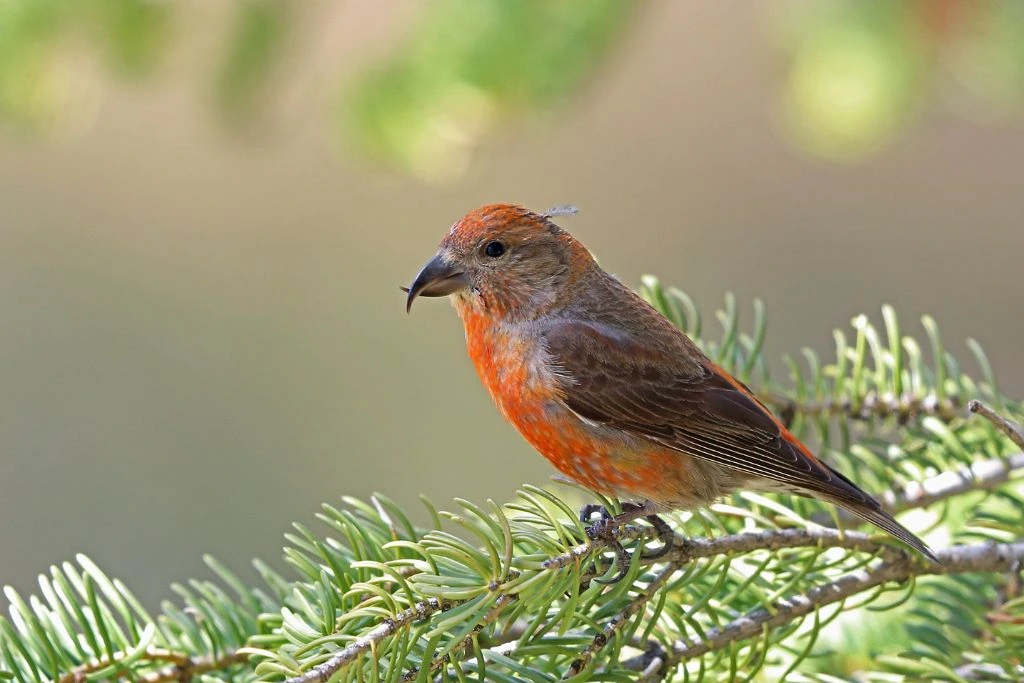
- Kingdom: Animalia
- Phylum: Chordata
- Class: Aves
- Order: Passeriformes
- Genus: Loxia Linnaeus
- Species: Loxia curvirostra
- Length: 5.5-6.5 in (14-17 cm)
- Weight: 1.4 oz (40 g)
- Wingspan: 10-10.75 in (25-27 cm)
In California, Red Crossbills are visible all year round. While some spend the mating season in the state’s north, others spend the winter months there. Male Red Crossbills are colored red and have darker tails and wings.
Red Crossbills spend the entire year in Northern and Western states and, if cone harvests are inadequate, spend the winter in Eastern states. Red Crossbills are primarily found in coniferous forests. However, they can also be seen feeding in the mornings along roadside gravel. They hunt in groups from tree to tree while eating conifer seeds, even breaking closed cones with their strong beaks.
9. Evening Grosbeak
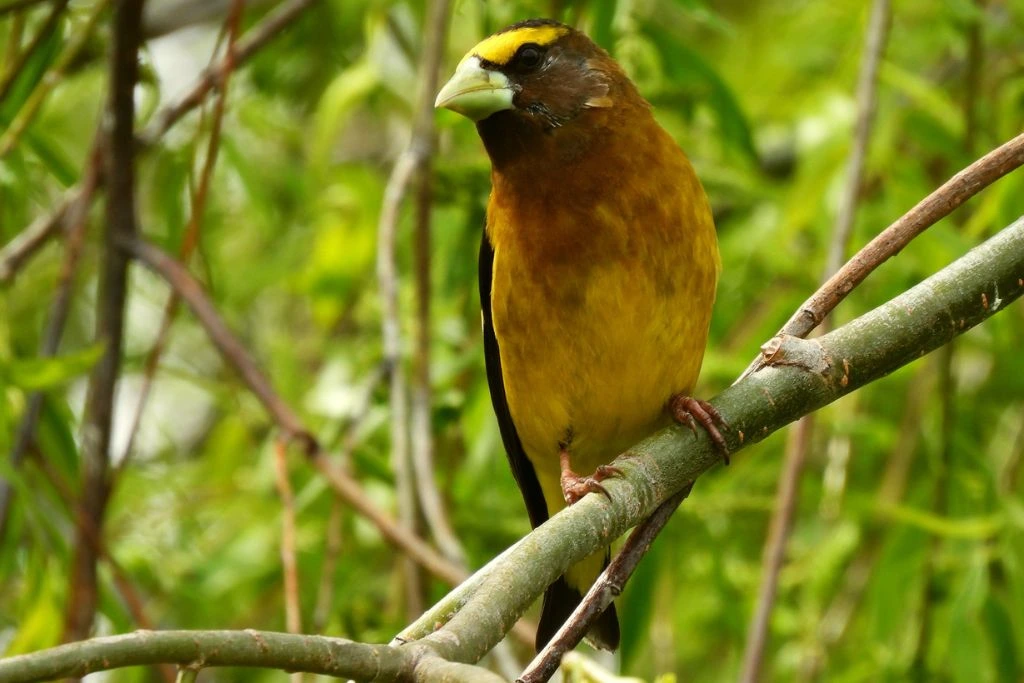
- Kingdom: Animalia
- Phylum: Chordata
- Class: Aves
- Order: Passeriformes
- Genus: Hesperiphona Bonaparte
- Species: Hesperiphona vespertina
- Length: 16 to 22 cm (6.3 to 8.7 in)
- Weight: 38.7 to 86.1 g (1.37 to 3.04 oz)
- Wingspan: 30 to 36 cm (12 to 14 in)
Although Evening Grosbeaks are a threatened species in California, they are generally visible from April until August. Big-billed, Evening Grosbeaks have distinctive yellow and black plumage. Adult males have an aggressive-looking yellow stripe across their eyes.
Evening Grosbeaks are year-round residents of Southern Canada, the West Coast, and Northern California. They will, however, go south to most US states if cone crops are poor. The natural food sources of Evening Grosbeaks are flower buds in the spring, insect larvae from trees in the summer, and seeds, berries, and tiny fruit in the fall and winter.
10. Gray-Crowned Rosy-Finch
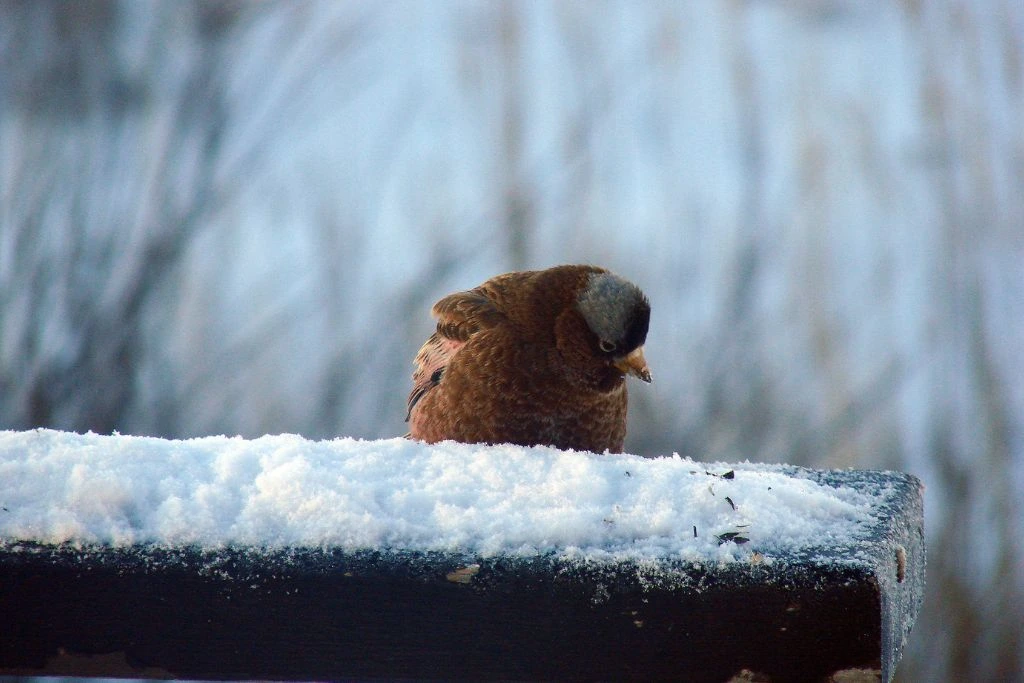
- Kingdom: Animalia
- Phylum: Chordata
- Class: Aves
- Order: Passeriformes
- Genus: Leucosticte Swainson
- Species: Leucosticte tephrocotis
- Length: 5.5-8.3 in (14-21 cm)
- Weight: 0.8-2.1 oz (22-60 g)
- Wingspan: 13.0 in (33 cm)
Although they are uncommon in California, Gray-Crowned Rosy-Finches have been seen during the breeding season, mostly in the state’s Eastern regions. Large and bulky, the Gray-Crowned Rosy-Finches are standard-sized birds. Adults can be recognized by their black forehead and throat, gray crown, brown body, and pink belly accents.
Before wintering in the Western United States, Gray-Crowned Rosy-Finches breed in Alaska and Western Canada. In the summer, the Gray-Crowned Rosy-Finch forages for insects and worms frozen in snowy mountains, glaciers, and meadows. They consume weeds, mustard, and sunflower seeds in the winter.
Frequently Asked Questions
How do California Finches look?
Adult males have a rosy-red face, upper breast, and a streaky brown back, belly, and tail. The red rump stands out in flight. Adult females are grayish-brown with tough outer, pixelated streaks and an unidentifiable face rather than red.
Is it common to see finches in California?
In California, it’s typical to observe House Finches close to people. Search for them in backyards, parks, buildings, and other urban and suburban places.
How can a finch and a sparrow be distinguished from one another?
While sparrows have longer legs and are sometimes pale pinkish, finches have shorter legs and are typically dark gray. Sparrows have more detailed and varied patterns than finches, which are plainer and less patterned.
What are the four different kinds of finches?
Crossbills, Evening and Pine Grosbeaks, Redpolls, and Siskins are a few of these. The Fringillidae birds have small, conical bills, short necks, and strong jaw muscles. Additionally, they have distinct flight cries, notched tails, and relatively pointed wings.
Are Californian House Finches native?
Except for the northern and mountainous areas, the House Finch, or Linnet, Carpodacus mexicanus frontalis (Say), is a protected migratory nongame bird, native to California.

